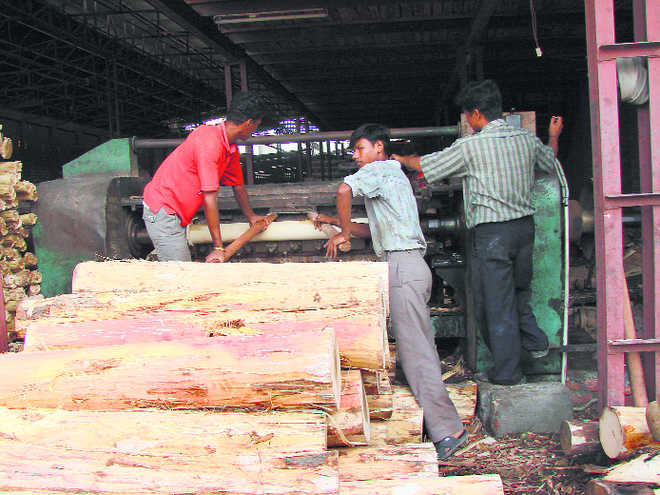RK Sapra
The city of Yamunanagar derives its name from the Yamuna that flows on the north-eastern side of the district. In the pre-Partition days, timber logs from Shivalik hills of Himachal Pradesh (then part of Punjab) used to be transported through the river for marketing. This facilitated the evolution of the timber market in this city. Over the years, this city has become a hub of wood-based industries producing more than 50 per cent of the plywood of the country. Hence, it is called the “plywood capital of India”. This hub has not only halted the spread of Chinese plywood in the country but is also exporting wood products to other countries.
Yamunanagar city is famous for old industrial culture—Ballarpur Paper and Straw Board Mills Ltd. was established here way back in 1928. This unit had initially used forest grasses, inferior woods and agro-wastes as raw materials but later shifted to pulp wood of eucalyptus during 1970s.
This played a crucial role in promoting eucalyptus farming. This city is surrounded by Uttar Pradesh, Uttarakhand, and Himachal Pradesh where forest departments, WIMCO and the Forest Research Institute, Dehradun, promoted farming of eucalyptus and poplar. Their efforts led to large scale production of farm-grown wood in this region. The arrival of farm-grown wood was approximately 26 lakh tonnes, valuing about Rs 1,000 crore in the Yamunanagar timber market during 2006-07. To regulate timber trade, the Haryana Government has recently established timber markets at Manakpur village on the Paonta Sahib road and on the Saharanpur road. The annual turnover of this market suggests that about Rs 500 crore is going back to farmers.
Due to a longer harvesting cycle of poplar (about 10 years), timber in very less quantity was available. Hence, plywood and veneer units faced a shortage of raw material during 1980s. During 2000s, these units imported machinery from China which could peel smaller-size logs with more recovery of veneers. This development led to poplar farming by a large number of farmers with a shorter harvesting cycle (about 5 years), which not only increased the availability of timber but also reduced the cost of raw material. Even pioneer farmers such as late Surinder Singh Hara, who used to grow average poplar trees weighing about 10 quintals over the 10-year cycle, faced difficulties in marketing timber. Hence, he was forced to reduce the harvesting cycle.
After the closure of plywood and veneer units in the north-eastern region (Assam, Meghalaya etc) on the orders of the Supreme Court in 1996, the exponential growth of such units took place in Yamunanagar due to sustained availability of raw material. At present, there are 570 plywood and veneer units and 368 subsidiary units in the district which manufacture doors, windows, shutters, ‘chowkhat’ and other shuttering material. These units are equipped with laboratories that conduct research and design wood for specific purposes such as truck bodies, railway coaches and other fire resistant materials. These units employ about one lakh people who are earning about Rs 900 crore annually. The buoyant timber markets, industrial culture, availability of skilled and semi-skilled labour, strategic location, and liberal policies of the state government led to the concentration of the wood-based industry in the city.
At present, the agro-forestry sector is passing through a downward phase as the prices of timber have decreased by 40 per cent to 50 per cent during the last six years due to lesser demand of wood products caused by a slowdown in the economy and undue competition from imported timber. Farmers have started harvesting their crops pre-maturely, causing financial losses to them and loss of wood production and employment. As the annual import of wood and wood products in the country is about Rs 42,000 crore, the state government should approach the Union Government for regulating their import to protect the interests of local farmers. Another 100 new plywood and veneer units have come up in this city after new licences were issued, resulting in improvement in the prices of farm-grown wood.
To further strengthen the wood-based industry in Haryana, Devendra Chawla, president of the All India Plywood Manufacturers Association, advocates establishment of a dry port at Yamunanagar. He says that face veneers and chemicals are quite costly, as they are transported from the Kandla port in Gujarat. The governments of Uttar Pradesh, Punjab, Chhattisgarh and Bihar are providing incentives in the form of cheaper land, electricity and reduced licence fees for establishing plywood and veneer units in those states. Hence to maintain an edge, the Haryana Government may also provide similar incentives to entrepreneurs and establish an industrial area and a Transport Nagar in Yamunanagar.
The Haryana Government may also invite leading players to set up medium density fibre board and furniture units in the state that have an assured supply of raw material in the form of Yamunanagar timber market through further relaxation of conditions under its “ease of doing business” programme. These measures will protect the interests of farmers, generate employment opportunities, boost government revenue, including foreign exchange, and contribute towards environment conservation.
(The writer is Member, State Environment Impact Assessment Authority)
Unlock Exclusive Insights with The Tribune Premium
Take your experience further with Premium access.
Thought-provoking Opinions, Expert Analysis, In-depth Insights and other Member Only Benefits
Already a Member? Sign In Now











